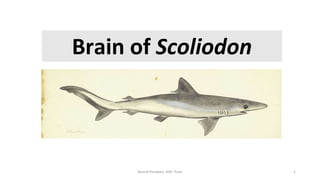
Brain of scoliodon
- 1. Brain of Scoliodon Nusrat Perween, AISC Pune 1
- 2. The nervous system of Scoliodon includes: (i) The central nervous system (CNS) (ii) The peripheral nervous system (PNS) (iii) The autonomous nervous system (ANS) Nusrat Perween, AISC Pune 2
- 3. (i) Central nervous system: (a) Brain: (b) Spinal cord: (ii) Peripheral nervous system: • cranial nerves and spinal nerves. (iii) Autonomous nervous system: • series of paired ganglia (sympathetic and parasympathetic) Nusrat Perween, AISC Pune 3
- 4. Introduction • Brain of shark is heavy and large • Externally covered by cranium, made up of cartilage and two connective tissue membranes called meninges • thick membrane dura- mater and thin membrane close to brain pia- mater • Brain and spinal cord is hallow from inside and cavities called ventricles • Space between meninges and ventricle of brain are filled with cerebro-spinal fluid • Special feature- Olfactory lobes and cerebellum well developed Nusrat Perween, AISC Pune 4
- 5. Brain of Scoliodon The brain is divided into three primary parts: (a) Forebrain or Prosencephalon (b) Midbrain or Mesencephalon (c) Hindbrain or Rhombencephalon 5
- 6. a) Forebrain or Prosencephalon Two part 1) Telencephalon- i. Olfactory lobes ii. Cerebrum 2) Diencephalon 6Dorsal view Ventral view
- 7. i) Olfactory lobes • Anterior end of cerebral hemisphere arise two stout olfactory peduncles; each terminates into a large bilobed olfactory lobe 1. Olfactory bulb 2. Olfactory sac 3. Olfactory peduncle • Cavity of olfactory lobe- Rhinocoels (1st ventricle) • Function- sense of smell 7 Nusrat Perween, AISC Pune
- 8. ii) Cerebrum • 2nd part of Telencephalon • massive undivided mass of nervous tissue • larger than other fishes. • Neuropore- ventrally on the cerebrum, through which terminal or pre- olfactory nerve comes out • Cavities – paracoels or lateral ventricles (2nd ventricle) • Function- all voluntary activities Nusrat Perween, AISC Pune 8
- 9. 2. Diencephalon • Present behind cerebrum (The posterior part of forebrain) • Completely covered by cerebellum on dorsal side i. Epithalamus (Pineal body) ii. Hypothalamus iii. Infundibulum iv. Optic chiasma v. Pituitary gland (hypophysis) 9 Nusrat Perween, AISC Pune
- 10. i. Anterior choroid plexus (telachoroidea): • The roof of the diencephalon is thin, non-nervous and highly vascular known as the anterior choroid plexus. • Secretes cerebrospinal fluid and supplies nutrition to cavities of brain ii. Epithalamus: • It comprises of epiphyris or pineal organ and habenular gangalia • Pineal body arises from posterior mid-dorsal end of diencephalon • Long and tubular • The lateral walls of the diencephalon form two thickened bodies called thalami. • Function- not known, may be involved in reception of light 10
- 11. iii. Hypothalamus • Ventral part of diencephalon • Very well developed in fishes • Contains neuro-secretory cells • Functions- secretes neuro-secretary material iv. Infundibulum • Arises from floor of diencephalon • Along the sides there are thick walled sacs called inferior lobes • Near distal end of each inferior lobe is wrinkled glandular sac called saccus-vasculosus • Saccus-vasculosus is highly pigmented ,vascular and folded • Saccus-vasculosus function- depth reception, secretion of ventricular fluid 11
- 12. v. Optic chiasma • On ventral side of brain in front of infundibulum the two optic nerves arising from each eye ball cross and form optic chiamsa (X) vi. Pituitary gland • Large in elasmobranchs • Present on ventral side behind the infundibulum (hidden) • Divided into 3 parts- Anterior, dorsal and ventral lobes • Ventral lobe –prominent secretes TSH and FSH • Cavity of diencephalon is called as diocoel (3rd ventricle) • Both cavities are join through foramen of Monro 12
- 13. • Dorsally and ventrally covered by cerebellum and infundibulum • large and consists of two round optic lobes. • Ventricle –optocoel connected to diocoel by iter or aqueduct of sylvius • Function –sense of vision 13 Midbrain or mesencephalon
- 14. Hindbrain or Rhombencephalon i. Cerebellum ii. Medulla oblongata 14 Nusrat Perween, AISC Pune
- 15. • Highly developed cerebellum and a medulla oblongata. • Rhomboidal in shape • The dorsal surface of the cerebellum shows irregular folds • Median longitudinal furrow – right and left halves • Two transverse furrow- three lobes • Cavity – epicoel • Function- center of co-ordination of body movement 15 i. Cerebellum
- 16. • Posterior most part of brain • Triangular in shape • anterior end gives a pair of hollow corpora restiformia • The roof of the medulla oblongata is non-nervous and highly vascular and form posterior choroid plexus that projects into ventricle and provide nourishment • The hind- brain controls swimming movements. • Cavity – metacoel or 4th ventricle • Function- controls involuntary activities 16 ii. medulla oblongata or myelencephalon
- 17. Nusrat Perween, AISC Pune 17 Nusrat Perween, AISC Pune
- 18. 18 1. Olfactory lobes- Rhinocoel or 1st ventricle 2. Cerebrum- paracoels or lateral ventricles (2nd ventricle) 3. Diencephalon- diocoel (3rd ventricle) 4. Both diocoel are join through foramen of Monro 5. Optic lobes- optocoel 6. Optocoel is connected to diocoel by iter or aqueduct of sylvius 7. Cerebellum- epicoel 8. Medulla oblongata- metacoel or 4th ventricle Cavities or ventricles of brain